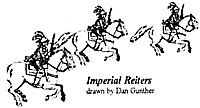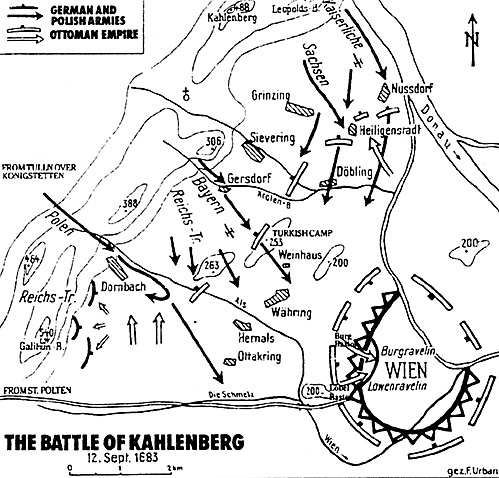 This article came about in rather strange
circumstances. At the hobby shop Something
Unusual in Eagle Rock, after a miniature battle
of Poles vs. Swiss with WRG Renaissance Rules
2nd Ed. a fellow PSW member asked about the
King John Sobieski's Poles that saved Vienna,
Austria from falling to the polyglot Turkish Army
of Grand Vizier Kara Mustafa. I knew I had info
somewhere about the siege and relieving armies,
acquired while I was in 'Stamboul, so I promised
to him the information later. Of course, one
thing led to another, and I never got him the info.
Later as I dug into my archives for another
subject, a wealth of material about the campaign
and the siege came to light. Since I'm now
building several Turkish armies, I reread my
notes, and with Tim Daun and John Haves urging
me to do so, I decided to do an article on the
campaign. So here is the information promised a
year ago to that forgotten PSW member (good
things come to those who wait.)
This article came about in rather strange
circumstances. At the hobby shop Something
Unusual in Eagle Rock, after a miniature battle
of Poles vs. Swiss with WRG Renaissance Rules
2nd Ed. a fellow PSW member asked about the
King John Sobieski's Poles that saved Vienna,
Austria from falling to the polyglot Turkish Army
of Grand Vizier Kara Mustafa. I knew I had info
somewhere about the siege and relieving armies,
acquired while I was in 'Stamboul, so I promised
to him the information later. Of course, one
thing led to another, and I never got him the info.
Later as I dug into my archives for another
subject, a wealth of material about the campaign
and the siege came to light. Since I'm now
building several Turkish armies, I reread my
notes, and with Tim Daun and John Haves urging
me to do so, I decided to do an article on the
campaign. So here is the information promised a
year ago to that forgotten PSW member (good
things come to those who wait.)
The Campaign of 1683
By 1676 the Turkish empire under the strong hand of the Koprulu dynasty had almost recovered all the territory it once held in the days of Suleiman the Great. While the current Sultin, Mehmed IV was a weak ruler, interested only in the hunt, his Grand Vizier, Merzifonlu Kara Mustafa Pasha. brother-in-law of the dynamic Ahmed Pasha, planned even more imperial conquests. He saw Austria as the Turkish main enemy, and planned its complete downfall.
In order to undermine Austrian authority, he gave aid to the Hungarian rebels under Count Tokoly, and refused to treat with Austria on administration of questionable border areas. It is has always been assumed that the Grand Vizier used fabrications of Austrian transgressions to convince the Sultan to declare war It is hard to believe that Austria in its fragile state, would deliberately antagonize the Ottomans.
In early March of 1863, the Sultan mobilized his forces. Placed under the command of Kara Mustafa, a Turkish army numbering 300,000 (including supports and camp followers) departed Adrianople, March 31st and began the fateful march toward its "high water mark."
The Hapsburgs of Austria, in contrast, had major unity problems. The Emperor Leopold I, who considered himself an absolute ruler in the mold of Louis XIV with a stalwart army, only had this faculty in his imagination. The reality was, his "empire" was extremely fragmented. His armies had just barely suppressed rebellions of the Hungarian, Bohemian and Croatian principalities, and while the Imperial Army was one of the largest in Europe, all veterans of the 30 years war, it was broke. The constant struggle of the 30 years had absorbed the great nobles' estates, and the emperor's courtiers were destitute.
It fall to the responsibility of one man, that the Turks did not dominate South-Cecntral Europe in this final campaign. This the Pope of the Catholic Church, Innocent XI Odescalichi. His untiring efforts against what he saw as the one main enemy of Christianity, the infidel. was rewarded by the formation of a coalition of petty princes and kings. all resolved to save Austria from the Turk. The Pontiff, used his religious powers also his secular ones', between the threat of excommunication, and the opening of the papal coffers, a coalition army was forged.
Meanwhile. the Turks were on the march. Muslafa foolishly boasted (no doubt to demoralize the defenders) that his objective was to take Vienna, then swing north and subjugate Carcow. This only had the effect of driving the Poles under its warrior king John Sobieski into the coalition. With the addition of the non-jaded, modernized Polish army, the coalition now had its sword edge.
Vienna was in no state to stand a siege. Recently devastated by a plague, its inhabitants had two choices, flee, or straighten fortifications. The Imperial Court picked the former and left on July 7th, with 60,000 citizens following its example. The remainder of the populace, too poor to relocate, began to rebuild Vienna's forts and walls.
The next day the Imperial army, 11,000 strong, under the command of Charles, Duke of Lorraine, arrived and went into garrison around the city. Vienna would fight. The popular Count Starhemberg was appointed the military governor of the city.
By the 13th. Turkish Akinji (light cavalry) had cut communications with the rest of Europe. The garrison attempted sallies to destroy the Turkish heavy guns, the only weapons that would rapidly bring the siege to a close. During one of these sallies Starhemberg was wounded. On July 15, 1863 the city was totally encircled, the Turks driving the last outpost, on the Danube islands back into the city. The defenders were down to 7,000 men. Turkish loses at this time are unknown, but were presumed to be heavy, especially among their elite troops.
By the 20th the Turkish engineers were at workthe main walls were being mined by digging underground shafts. The Imperials countermined, with many tiny battles being fought under the ground.
On August 12th the Turks penetrate and take the last of the outer works. The hand writing was on the wall, Vienna would soon fall, unless relief comes.
On the 13th 20 volunteer scouts left the city to pass through Turkish lines to request immediate aid.
September 3rd, 1863, the Turks reached and began mining the main wall surrounding Vienna. On the 4th, they blow a breach and storm the Berg bastion. (At right: top arrow on map)
The Imperials in turn, force them out but only after taking severe losses. The breach cannot be completely repaired. Precious troops must guard it around the clock.
 By the 9th the end is near. Turkish Jannissaries
storm and take the Lobel bastion. the Mayor of
Vienna, Liebenberg, falls leading the defence. (At right: bottom arrow on map)
By the 9th the end is near. Turkish Jannissaries
storm and take the Lobel bastion. the Mayor of
Vienna, Liebenberg, falls leading the defence. (At right: bottom arrow on map)
September 11th: the last mine explodes and topples a curtain wall. (At right: bulge in city wall on map)
The defenders, down to around 5,000 troops, perhaps 10,000 civilians, exhausted, weakened from dysentery and dying of cholera, prepare to make a final stand in the streets. Grand Vizier Kara Mustafa sends a final ultimatum to the beleaguered garrison: surrender now or accept your annihilation. The garrison is too tired to reply.
Kara Mustafa also sends a declaration to his Padishah: Vienna has fallen! Both messages would prove at best, to be premature.
Next, Sobieski Saves Vienna! A look at the armies and leadership on both sides.
Back to Table of Contents The Messenger April 1996
Back to The Messenger List of Issues
Back to MagWeb Magazine List
© Copyright 1996 by HMGS/PSW.
This article appears in MagWeb.com (Magazine Web) on the Internet World Wide Web.
Other articles from military history and related magazines are available at http://www.magweb.com